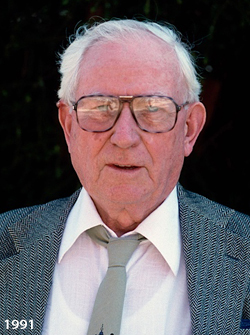
Council of Heads of Australasian Herbaria
Australian National Herbarium
Biographical Notes
 |
Council of Heads of Australasian Herbaria |
 Catcheside, David Guthrie (1907 - 1994)
Catcheside, David Guthrie (1907 - 1994)Best known as a geneticist of international repute, David Catcheside was also a plant collector, specialising in mosses.
Born on 31 May 1907 at Hampshire, England; died in Adelaide on 1 June 1994 aged 87.
He was the elder child of British-born parents David Guthrie Catcheside, drapery warehouse assistant, and his wife Florence Susanna, a teacher.
David junior won a scholarship to Strand School, Brixton Hill, (1918-24) where an enthusiastic schoolmaster, S.T.S. Dark, encouraged his interest in natural history, especially mosses, through the natural history society's program and bryological field trips. This led to his study of botany at King's College, London (BSc Hons, 1928).
He was a Lecturer in Botany at King's College London from 1933 to 1936, gaining a DSc in 1936. He was at the University of Cambridge from 1937 to 1950.
He was made a Fellow of the Royal Society in 1951.
He was appointed in 1952 as the foundation Professor of Genetics at the Waite Agricultural Research Institute in Adelaide, where he established Australia's first university department of genetics.
He returned to the United Kingdom to become Professor of Microbiology at the University of Birmingham (1956-1964). Here his main intention was to form a research group working in the new field of molecular biology.
In 1958 he was President, British Lichen Society.
In 1966, after three years at the John Curtin School of Medical Research, Catcheside became the foundation Director of the Research School of Biological Sciences at the Australian National University.
He retired in 1972.
In 1976 he and wife Kathleen moved to Adelaide, where their children were now both living. There he became an Honorary Research Associate at the Waite Institute, where he devoted time to his long-standing, and actively maintained, interest in mosses.
This was more than a casual hobby. The seriousness of his commitment was demonstrated by the publication in 1980 of his third book, Mosses of South Australia, a comprehensive account illustrated throughout by his own clear line drawings of the diagnostic characters. The book was based upon his own field work and microscopic observation, combined with library research to clear up confusions regarding species names. It was warmly received in the bryological community.
David continued to publish occasional papers on the moss flora until 1993, partly in collaboration with the bryologist Ilma G. Stone. One of his last papers (with Stone) described two new species.
He made many donations to the Adelaide Herbarium, and eventually bequeathed to it his entire bryophyte collection together with his microscopic slides and library.
Hhe died in Adelaide on 1 June 1994 and was cremated.
The D.G. Catcheside prize was established by the GSA to honour his memory.
His son, David, became professor of biological sciences at Flinders University, Adelaide.
Source: Extracted from:
https://www.eoas.info/biogs/P000301b.htm
https://www.science.org.au/fellowship/fellows/biographical-memoirs/david-guthrie-catcheside-1907-1994
https://research.monash.edu/en/publications/catcheside-david-guthrie-1907-1994
https://adb.anu.edu.au/biography/catcheside-david-guthrie-27834
Portrait Photo: 1991, M.Fagg, taken at ANBG.
Data from 3,165 specimens
